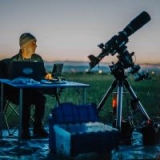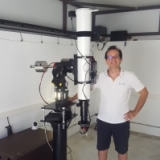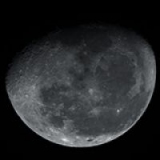INDI Library v2.0.7 is Released (01 Apr 2024)
Bi-monthly release with minor bug fixes and improvements
New KStars/Ekos Module: Analyze
- Hy Murveit
-
 Topic Author
Topic Author
- Offline
- Administrator
-

- Posts: 1222
- Thank you received: 565
Replied by Hy Murveit on topic New KStars/Ekos Module: Analyze
Internal guider, see
invent.kde.org/education/kstars/-/blob/m...uide/gmath.cpp#L1242
SquareError(t) = ((RA(t) - RA_target(t))**2 + (DEC(t) - DEC_target(t))**2)
In the PHD2 case, the RA(t) - RA_target(t) or diff_ra_arcsecs is taken straight from PHD2 (PHD2 calculates that and sends it to Ekos).
See invent.kde.org/education/kstars/-/blob/m...lguide/phd2.cpp#L487 for PHD2 part.
So, in the PHD2 case, Ekos is taking as the RA or DEC error, what PHD2 says is the RA or DEC error.
Analyze implements an IIR filter with an approximate time constant of 40 samples (nothing magic about 40 samples == about 2 minutes with 3s samples)
// initialize
filteredRMS = 0;
constexpr double timeConstant = 40.0;
rmsFilterAlpha = 1.0 / pow(timeConstant, 0.865);
// at every time sample (x below is SquareError(t) above)
filteredRMS = rmsFilterAlpha * x + (1.0 - rmsFilterAlpha) * filteredRMS;
invent.kde.org/education/kstars/-/blob/m...yze/analyze.cpp#L485
and takes the sqrt of the (poorly named) filteredRMS to get the rms value you see. (I guess I should have named it filteredSquareError).
invent.kde.org/education/kstars/-/blob/m...yze/analyze.cpp#L542
It does not take the mean of the RA or DEC samples. I understand your logic, though, why that might be nice.
All that said, that's not quite true for the case of RMS error printed in the Details box, e.g. when you click on a guide timeline session or a capture timeline session.
There, it does not use an approximate IIR filter, but rather computes exactly the sqrt of the sum of the square error in the interval.
In any event, just to be clear, this is what is currently implemented.
Happy to entertain suggestions,
Hy
Please Log in or Create an account to join the conversation.
- Ferrante Enriques
-

- Offline
- Elite Member
-

- Posts: 249
- Thank you received: 62
Replied by Ferrante Enriques on topic New KStars/Ekos Module: Analyze
@Rick, I'm thinking to use the .analyze file as the only source of information for Astrodom. What do you think?
ferrante
Please Log in or Create an account to join the conversation.
Replied by Ken Self on topic New KStars/Ekos Module: Analyze
What would be really neat would be the RMS over the course of each capture to identify which ones might be sub-optimal due to poor guiding.
For info: The PHD2 remote interface returns the simple distance from the star centroid to the lock point. But in the Log Viewer (and I think also in the application but I havent checked) the RMS calculation subtracts the mean of the set from each sample before then calculating the RMS. So what is shown on the PHD2 screen is the RMS about the mean offset. What I think of as the "DC offset".
Please Log in or Create an account to join the conversation.
- Rick Bassham
-
- Offline
- Elite Member
-

- Posts: 216
- Thank you received: 120
Replied by Rick Bassham on topic New KStars/Ekos Module: Analyze
@fenriques I think that would be fine. Might simplify things a lot for you, but it would tie your software really closely with Ekos, meaning anyone who uses other tools wouldn't be able to use it. But since I only use Ekos for imaging at the moment, it wouldn't affect me.
Please Log in or Create an account to join the conversation.
Replied by fmozza on topic New KStars/Ekos Module: Analyze
Please Log in or Create an account to join the conversation.
- ALESSANDRO PENSATO
-

- Offline
- Elite Member
-

- Posts: 334
- Thank you received: 23
Replied by ALESSANDRO PENSATO on topic New KStars/Ekos Module: Analyze
Please Log in or Create an account to join the conversation.
Replied by Ken Self on topic New KStars/Ekos Module: Analyze
Please Log in or Create an account to join the conversation.
Replied by Andrew on topic New KStars/Ekos Module: Analyze
Question: The RGB color coding is quite clear. But what about narrowband and calibration frames? I'm thinking you went with something along these lines?
Ha: Dark Red
S: Yellow
O: Cyan
Luminance: White
Dark Frame: Black
Bias Frame: 50% Grey
Flat Frame: 25% Grey
Other: Magenta
Please Log in or Create an account to join the conversation.
Replied by Justin on topic New KStars/Ekos Module: Analyze
Please Log in or Create an account to join the conversation.
Replied by fmozza on topic New KStars/Ekos Module: Analyze
I had a sense there was some authority behind response to my original post ...
Not directly related to topic, but are there any other conditions that would cause an offset other than PA? PHD2 reports my PA between 0.5 arcmin to 3.2 arcmin, so I'm not sure that's the issue. So, some other force must be in play. I'm guessing its either balance or cabling. I'm wondering if is possible to get a hint from looking at the corrections.
jmh
Please Log in or Create an account to join the conversation.
- Andrew Burwell
-

- Offline
- Platinum Member
-

- Posts: 527
- Thank you received: 139
Replied by Andrew Burwell on topic New KStars/Ekos Module: Analyze
Please Log in or Create an account to join the conversation.
- Hy Murveit
-
 Topic Author
Topic Author
- Offline
- Administrator
-

- Posts: 1222
- Thank you received: 565
Replied by Hy Murveit on topic New KStars/Ekos Module: Analyze
invent.kde.org/education/kstars/-/blob/m...yze/analyze.cpp#L621
Note that I'm monitoring real-time processes, so some signals come in in awkward ways.
Let me know if there are other things you'd like to see in the file, or perhaps something like a header line that might make things more future proof.
Right now, the file has no header lines, but there's no good reason for that omission. I guess it does have a version header
#KStars version 3.5.0. Analyze log version 1.0.
It is very early in the evolution of Analyze, it's possible that I'll change the file format...though I have no such current plans.
Of course it would also make a lot of sense to make sure people can real old logs...
Still thinking this through.
BTW, I'd love to include more capture-related analysis (like you get from PixInsight files). Right now the only signal computed
is the HFR. I was waiting on @Rlancaste's StellarSolver software release, which was planned for KStars v3.5.0, as it was a
rework of the whole SEP/Sextractor framework for KStars. Not sure of his schedule, though.
Hy
Please Log in or Create an account to join the conversation.
